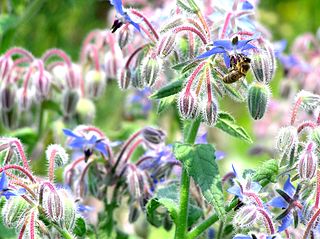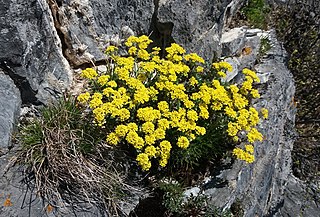
Boraginaceae, the borage or forget-me-notfamily, includes about 2,000 species of shrubs, trees and herbs in 146, to 156 genera with a worldwide distribution.

Nonea is a genus of flowering plants in the family Boraginaceae. Sometimes known as monkswort, these are herbaceous perennials or annual plants, native to Europe, Asia and Africa.

Pulmonaria (lungwort) is a genus of flowering plants in the family Boraginaceae, native to Europe and western Asia, with one species east to central Asia. According to various estimates there may be between 10 and 18 species found in the wild.

The genus Anchusa belongs to the borage family (Boraginaceae). It includes about 35 species found growing in Europe, North Africa, South Africa and Western Asia. They are introduced in the United States.

Boraginales is an order of flowering plants in the asterid clade. It includes the Boraginaceae and a number of other families, with a total of about 125 genera and 2,700 species. Its herbs, shrubs, trees and lianas (vines) have a worldwide distribution.

Cerinthe is a genus of flowering plants in the family Boraginaceae, known as honeyworts. The genus is characterised by a calyx made up of separate, rather than fused, sepals, a tubular corolla, and the schizocarpic fruit that divides into two parts at maturity, unlike most members of the family, where the fruit splits into four nutlets. The genus has a circum-Mediterranean distribution, ranging from the Irano-Turanian Region in the east to Morocco in the west.

Glandora diffusa, the purple gromwell, syn. Lithodora diffusa, Lithospermum diffusa, is a species of flowering plant in the family Boraginaceae. It is a mat-forming perennial growing to 15 cm (6 in) tall by 60 cm (24 in) or more wide, with dark green, hairy evergreen leaves and masses of blue or white 5-lobed flowers. It is suitable for cultivation in a rock garden or alpine garden.
Hoplestigma is a genus of flowering plants in the family Hoplestigmataceae. One study of pollen suggested that Hoplestigma might be related to the family Ehretiaceae. In a comparison of chloroplast DNA sequences in 2014, Hoplestigma formed a strongly supported clade with Coldenia and genera that have always been placed in Cordiaceae. The authors of that study recommended that Hoplestigma and Coldenia be included in Cordiaceae.
Lithodora nitida is a species of flowering plant in the family Boraginaceae. It is endemic to Spain. It is known by the common name viniebla azul.

Lithodora is a genus of flowering plants in the family Boraginaceae, native to southwestern Europe, southern Greece, Turkey and Algeria. They are low-growing, evergreen shrubs and subshrubs, producing 5-lobed blue or white flowers. The Greek lithodora literally means "stone gift", referring to the plant's preferred rocky habitats. The genus Glandora was split from Lithodora in 2008.
Wellstedia is a genus of flowering plants traditionally included in the family Boraginaceae s.l., but placed in its own family, Wellstediaceae within the Boraginales order, by the Boraginales Working Group.

Brunnera macrophylla, the Siberian bugloss, great forget-me-not, largeleaf brunnera or heartleaf, is a species of flowering plant in the family Boraginaceae, native to the Caucasus. It is a hardy, rhizomatous, herbaceous perennial, that can reach from 12 to 18 inches in height, and carries basal, simple cordate leaves on slender stems. Sprays of small blue flowers, similar to those seen in the related forget-me-nots, are borne from mid-Spring, and bloom for eight to ten weeks.

Boraginoideae is a subfamily of the plant family Boraginaceae s.s, with about 42 genera. That family is defined in a much broader sense in the Angiosperm Phylogeny Group (APG) system of classification for flowering plants. The APG has not specified any subfamilial structure within Boraginaceae s.l.

Codon is a small genus of plants from South Africa in the family Codonaceae in the order Boraginales. The genus Codon comprises two species.

Coldenia, named after C. Colden, is a monotypic genus of flowering plants traditionally included in the borage family, Boraginaceae sensu lato. It was assigned to the subfamily Ehretioideae, but molecular data revealed it to be more closely related to the genus Cordia, so that other authors placed in Cordioideae. Subsequently, it was placed in its own family, Coldeniaceae, within the Boraginales order, by the Boraginales Working Group.

Euploca is an almost cosmopolitan genus of plants with around 100 species. It was first described by Thomas Nuttall in 1837. While part of the broadly defined Boraginaceae in the APG IV system from 2016, a revision of the order Boraginales from the same year includes Euploca in the separate family Heliotropiaceae. Its species used to be classified in the genera Hilgeria and Schleidenia and in Heliotropium sect. Orthostachys, but were found to form an independent lineage in a molecular phylogenetic analysis, more closely related to Myriopus than to Heliotropium. While many species use the C4 photosynthetic pathway, there are also C3–C4 intermediate species. Species have leaves with a C4-typical Kranz anatomy.

Glandora prostrata, the shrubby gromwell, creeping gromwell or purple gromwell, is a species of Glandora native to Portugal, Spain and France. Its cultivars 'Grace Ward' and 'Heavenly Blue' have gained the Royal Horticultural Society's Award of Garden Merit.

Cerinthe major, called honeywort along with other members of its genus, is a species of flowering plant in the genus Cerinthe, native to the Mediterranean region, and introduced to New Zealand. Gardeners have a choice along a spectrum of cultivars ranging from Cerinthe major subsp. major, with sea-green bracts and yellow flowers, to Cerinthe major subsp. purpurascens with blue bracts and purple flowers.

Odontarrhena is a large genus of flowering plants in the family Brassicaceae. They were originally a separate genus and then were amalgamated into the Alyssum genus, but then morphological and molecular evidence has reseperated them. Some of the genera are nickel (Ni) hyperaccumulators.

Huynhia is a genus of flowering plants belonging to the family Boraginaceae, from Asia.

















